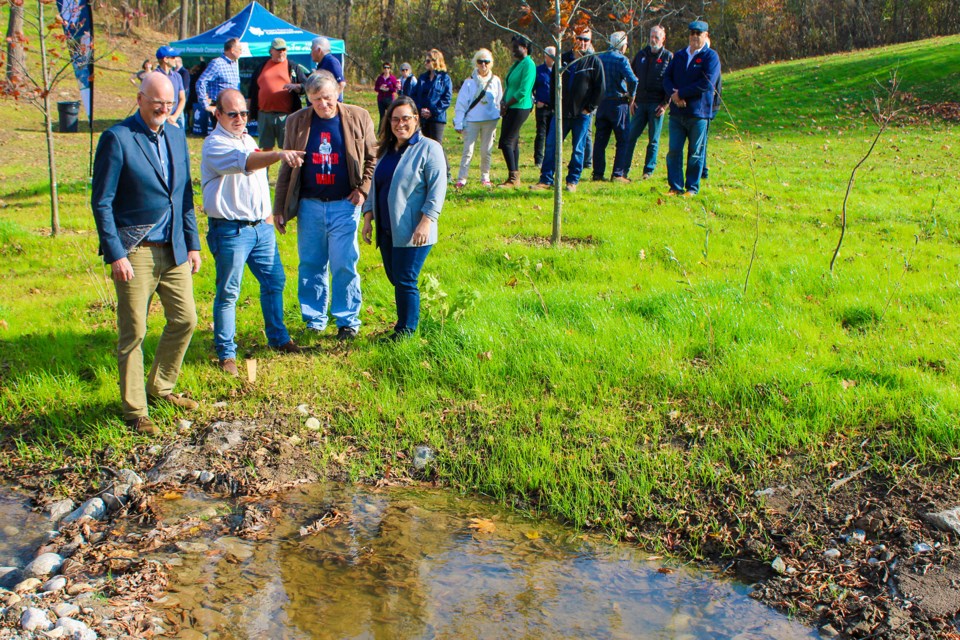There was one theme that came up again and again as the completion of restoration work at the headwaters of 12-Mile Creek in Pelham was celebrated. Words like partnership, co-operation and connections were bandied about to demonstrate how it was no one party, no one group, who was responsible but rather everyone pulling together.
Leilani Lee-Yates, chief executive for the Niagara Peninsula Conservation Authority, which wound up overseeing the restoration, said it was co-operation between many parties that helped get the job done.
“This project really exemplifies how partnerships between local landowners, environmental organizations and government bodies can bring about lasting, improvements to the health of our environment and our beloved 12 Mile Creek,” Lee-Yates said.
Pelham Mayor Marvin Junkin echoed Lee-Yates’ sentiment and said that as a farmer, stewardship of the land is something that is important to him. He recalled when he first saw the problem that erosion was causing in the area four years ago.
“When Brian Green from Trout Unlimited (the now defunct Niagara chapter) brought me down to see this, it physically made me sick,” he said. “It was a small-scale natural disaster.”
With the land being in private hands, there was little that could be done, Junkin said.
“We dumped it in Trout Unlimited’s hands,” Junkin said.
Together with Water’s Edge, who came up with the design, fundraising by Trout Unlimited, funding from the Town of Pelham and Niagara Region, cooperation from the landowner and management of the project by the NPCA, and donations of aggregates from Lafarge and Walker Industries combined to get the project done.
“The casual observer doesn't realize how many people, how many committees had to get together to make this thing work,” Junkin said. “It really is amazing and gratifying to see that when governments actually do get together, we can make good things happen.”
The Trout Unlimited Niagara chapter had secured $130,000 in federal grant funding from its Environmental Damages Fund for the project to go with donations of $55,000, and in-kind donations from Walker Industries and Lafarge in the form of aggregates. That was on top of just over $90,000 the group received from the Town. In total, the cost of the project was just over $300,000.
The doesn’t mean there weren’t problems.
Along the way, Trout Unlimited Canada decided to suspend the Niagara chapter not long before work was to begin on the restoration, over what it called administrative issues.
But members of the chapter, including Green were on hand Wednesday to see the results of their work.
“We recognized the need, I guess you could say, and did the base work, got it all together,” Green said. “And then, to be honest, probably the best thing that could have happened was that we turned it over to the NPCA. They did a fantastic job.”
The conservation authority, Green added, was well-suited to take on the project.
“With the experts they have and the infrastructure that they have and the connections with the municipal governments around here, they were able to bring it off in record time.”
The headwaters are crucial to the survival of the Brook Trout, said Steve Miller, who was the NPCA’s project manager for the restoration.
“However, urbanization and erosion have threatened their habitat,” he said. “The steep gradient of the creek’s channel has caused significant erosion, deepening the channel by more than four metres in some areas and sending harmful sediment downstream.”
The muddy water will suffocate any eggs laid by the fish.
“Those eggs are no longer viable,” Miller said.
The 110-metre stretch of the stream presented a challenge, Miller said, as the elevation drops 20 feet over that span, resulting in a fast-moving “waterslide” and cause erosion.
“The solution to that was to come up with a method of preventing the creek from eroding out, stabilizing it, and somehow allowing that water, that energy as it flows down that 20-foot drop.”
That’s where Water’s Edge Environmental Solutions came into the picture. The design features “rocky ramps” and pools that slow the water as well as “benches” on either side. During extreme rain events, the channel spills over and connects water to the floodplain.
“It serves to get rid of all that pent up energy in the water as it flows down that steep grade.” Miller said.
Some trees and vegetation had to be removed to complete the work, then 33 native trees and 233 native bushes were planted at the site, which is located immediately to the west of Pelham Cares.
The grass in the area is a “nurse crop” — the first step in establishing wildflowers in the area, Miller added.
“What a nurse crop does is it protects the native meadow seed mix that was planted underneath,” he said. “Next year, you're going to see wildflowers come up, purple cone flower, Black Eyed Susan, all in an effort to shade this cold-water system.”
